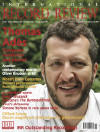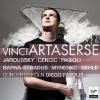Texte paru dans: / Appeared in:
*

International Record Review - (11/2012)
Pour
s'abonner / Subscription information
Virgin
6028692

5099960286925 (ID253)
Consultez toutes les évaluations recensées pour ce cd
~~~~ Reach all the evaluations located for this CD

” … Leonardo Vinci (c.1696-1730) was the prime mover in a new generation of Neapolitan composers who took the opera world by storm in the second and third decades of the eighteenth century. The appeal of his music to his contemporaries was summed up by Charles Burney several decades later when he praised Vinci’s supreme ability to express the words of the libretto ‘by simplifying and polishing [the] melody, and calling the attention of the audience chiefly to the voice part, by disentangling it from fugue, complication, and laboured contrivance’.
The elegance of Vinci’s vocal style appealed to singers too, whom he served well with melodic lines adorned in places with impressive-sounding runs and decorations, but elsewhere left plain and simple as scaffolding for singers’ own embellishments . As for the audience interested in the drama, Vinci wrote powerful recitatives (with atmospheric orchestral accompaniment at moments of high tension), and he quickly established character and mood through the vividly contrasted styles of his arias — which have an astonishing range. Vinci lived fast and wild — addicted to gambling and women — and died at the age of only 34 after drinking a cup of hot chocolate poisoned by the furious family of one of his conquests. Unusually for the time, Vinci’s operas outlived him (Handel arranged several for the London stage during the 1730s), but he has had to wait a long time for period performance resurrection . . . and now there are two of his operas in these pages on consecutive months.
Artaserse was staged in Rome in February 1730 just three months before that fateful cup of chocolate; it was to be Vinci’s last completed opera. Its initial run was cut short by the death of Pope Benedict XIII, but immediately after Vinci’s death it was enthusiastically revived in Italy and throughout Europe — where it even enchanted the French. Ultimately Artaserse achieved true classic status, becoming one of the best known Italian operas of the century: that rarest of things in a genre shaped by fashion conscious audiences interested in novelty rather than longevity. But Artaserse had strong foundations, with a libretto by the celebrated Pietro Metastasio which offered an unusually straightforward plot, believable motivation and powerful characterization. Metastasio himself referred to it as ‘the most fortunate of all my children’: fortunate because of the splendour of Vinci’s musical setting — the first of 90. The exceptionally starry cast also played a part in the work’s initial success. In Rome, of course, there was no question of women singing onstage, so the original cast was entirely male, boasting some of the best, and best-looking, castrati in the business, with the famous Carestini in the noble, long-suffering role of Arbace.
The libretto is rich in conflicts of considerable force which touch every character (goodies, baddies and the confused), while the theme of injustice drives the plot forward and makes for a compelling narrative right up to the final scene. Artabano, prefect of the Royal Guard, kills King Serse, to seize the Persian throne; but his son, Arbace, is the one who is unexpectedly arrested. Though horrified by the crime, he remains loyal to his father, who does little to set the injustice right. Semira never doubts Arbaces (her brother), but his lover Mandane does. Serse’s son Artaserse, who ascends the throne, finds himself in some tricky situations but retains his moral authority. Justice is finally done, Arbace is released, lovers are reunited and, at his son’s insistence , Artabano is mercifully treated.
As far as I am aware this is the first complete commercial recording of Artaserse with period instruments, and it’s a performance which serves the music and drama gloriously . The main moving force behind this project is the countertenor Max Emanuel Cencic (who also sings Mandane) . Crucially, he was responsible for casting, which is both faithful and fascinating. By returning to the original all male casting of the Roman premiere, we are presented with a line-up of five countertenors and one tenor (the evil Artabano). A risky undertaking you might think: no seductive sopranos to tempt the CD-buying public but a surfeit of cackling countertenors who might frighten us off. It’s true that there’s not as much tonal variety as one might expect in a mixed-sex cast, but the countertenors are tellingly contrasted and, in the female roles, Cencic and the high-voiced Romanian star Valler Barna-Sabadus bring a kind of objectivized femininity to their singing — neither cool nor camp but a captivating blend of the precise, elegant, dramatically tenacious and technically spellbinding — perfectly illustrated in the wide emotional vacillations of Cencic’s ‘Dimmi che un empio sei’.
The role of the wronged Arbace is the finest in the opera and, perhaps because he has some of the best arias, Franco Fagioli is the most captivating member of a very strong cast. I particularly enjoyed his effortless upper register and bravery in digging deep into his chest voice — the part vas designed to showcase Carestini’s huge range and ambition. Fagioli is unnervingly agitated in the memorable ‘Fra cento affanni’ after his father Artabano admits to regicide in Act 1, and soaringly dignified in ‘ Per quel paterno amplesso’ after he has been unjustly condemned for this crime by his father in Act 2. However, the real test of his bravura skills is the heroic coloratura simile aria ‘Vô solcando un mar’ which brings Act 1 to a close. Fagioli brings off the rapid articulation of the ‘A’ section perfectly and in the da capo he introduces fabulous extra complications of his Own: a textbook opera seria clap-inducing finale. This became one of the most popular arias of the eighteenth century and a perfect example of the early Classical style that Vinci pioneered during the 1720s.
I the title role Philippe Jaroussky is impressive too in arias which are less flashy and more measured in style than Arbace’s. The Act 2 opener ‘Rendimi il caro amico’ is one of the rare occasions when he raises his voice in a movingly outspoken plea to have his old friend Arbace back again. Jaroussky also brings terrific Neapolitan swagger to the tuneful ‘Non conosco’ , ornamenting the da capo lavishly. Indeed, the generous, but skilful ornamentation of the da capos by every singer here is one of the greatest pleasures of this performance — no wincing at ambitious mis-fires or stratospheric mishaps. If you are ever in danger of losing the thread of the drama, Vinci helpfully casts the wicked Artabano as the only tenor and Diego Fasolis underscores all his recitatives with a bassoon without any historical precedent, I think, but with plenty of dramatic justification. Daniel Behle depicts Artabano’s two sides deftly, playing both the wicked and the trapped-but-loving father roles with equal conviction right up to the final scene. After Arbace, Artabano gets some of the best music and Behle does the vigorous, blustering arias especially well, with all the confidence of the self-deluded — firm-toned and faultlessly agile.
Even though the dialogue has been trimmed down a fair bit, there’s still a lot of recitative in this opera which the cast animates with exceptional skill, especially in the long final scene six minutes of recitative and no arias — where all is revealed and everything put right. Fasolis draws wonderful things from Concerto Köln, which bounces along pertly to the chugging bass lines with which Vinci heralds the first inklings of the Classical style, while the brass players bray boldly and, in ‘Vo solcando’ , chunter charmingly.
This is an outstanding performance and the most important Baroque opera discovery of the year so far. I can’t recommend it highly enough, especially if you like countertenors.
Cliquez l'un ou l'autre
bouton pour découvrir bien d'autres critiques de CD
Click either button for many other reviews


